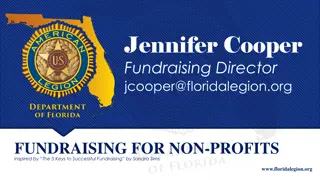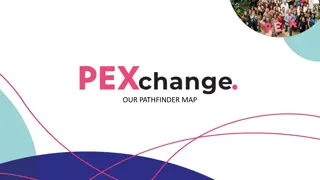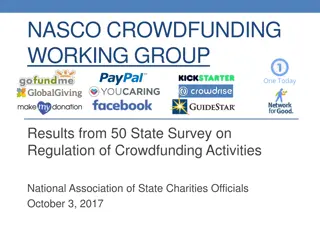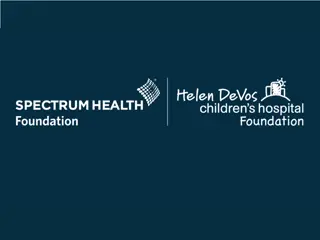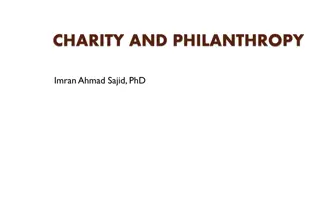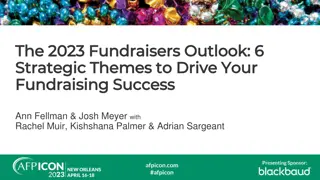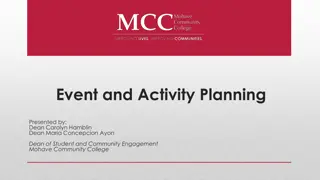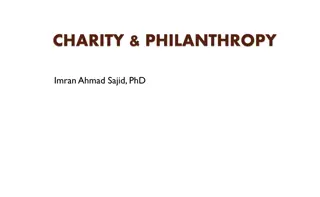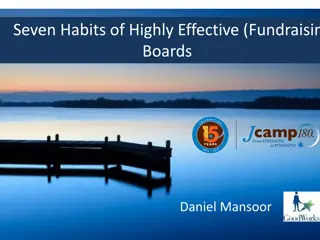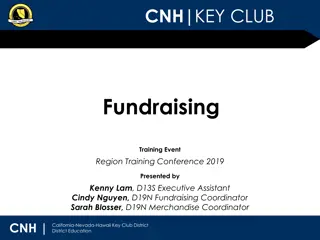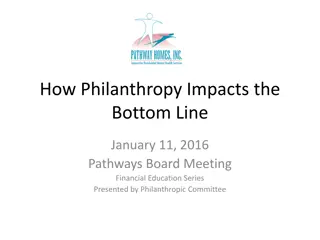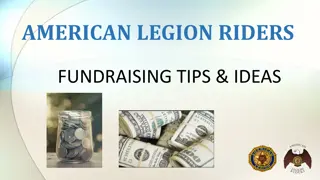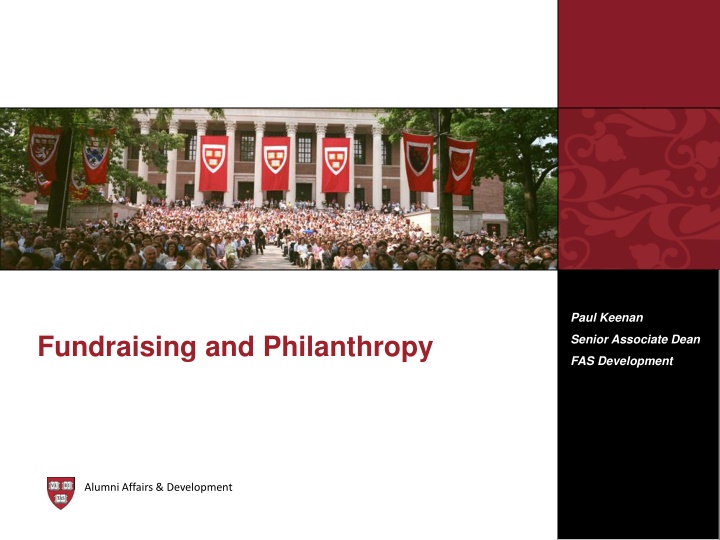
Importance of Fundraising for Non-Profit Organizations
Discover why fundraising is crucial for non-profit organizations, the significant impact of private philanthropy, and how it contributes to the excellence of educational and cultural institutions. Learn about the varied sources of philanthropic support and the essential role it plays in achieving strategic academic goals.
Download Presentation

Please find below an Image/Link to download the presentation.
The content on the website is provided AS IS for your information and personal use only. It may not be sold, licensed, or shared on other websites without obtaining consent from the author. If you encounter any issues during the download, it is possible that the publisher has removed the file from their server.
You are allowed to download the files provided on this website for personal or commercial use, subject to the condition that they are used lawfully. All files are the property of their respective owners.
The content on the website is provided AS IS for your information and personal use only. It may not be sold, licensed, or shared on other websites without obtaining consent from the author.
E N D
Presentation Transcript
Paul Keenan Fundraising and Philanthropy Senior Associate Dean FAS Development Alumni Affairs & Development
Why Does it Matter? Non-profit organizations raise money because income generated from normal operations is insufficient to support the organization s mission. A wide array of organizations raise funds: Churches (35% of all giving) Schools (14%) Social service and relief organizations (9%) Hospitals (8%) Arts & Cultural organizations (5%) Fundamentally, the process of fundraising is the same across all types of organizations, however specific challenges will vary widely depending on the type of organization and its mission.
Why Does it Matter: More than $ $211,770,000,000 was given away by individual donors in 2010. Beyond the impact of the dollars, private philanthropy also strengthens non-profits by moving them toward greater transparency, accountability and discipline because institutions must articulate and defend their vision, priorities, and strategy for achieving them when asking donors for support. In offering to fund our objectives, donors challenge us to test our assumptions, resist complacency and demonstrate that we are being true to our ambitions.
Why Does it Matter: Margin of Excellence Private philanthropic support has provided that margin of excellence that has separated American educational and cultural institutions from peers around the globe World s top universities as ranked by Shanghai Jiaotong University, 2011 1 Harvard 2 Stanford 3 MIT 4 UC Berkeley 5 Cambridge 6 Caltech 7 Princeton 8 Columbia 9 Chicago 10 Oxford
Why Does it Matter: Patchwork Quilt Philanthropy is embedded in our national strategy for supporting education Students, individual alumni, philanthropic foundations, private businesses and industry and State and Federal Governments all share the responsibility of supporting our colleges and universities, and this is as it should be. - US Dept. of Education
Defining the Case Fundraising goals flow from the institution s academic or strategic plan the plan determines your case for support Fundraising is a means to achieving strategic academic goals, not a goal in itself The academic plan should provide fundraising staff with the ability to answer the following key questions: What is the leadership s vision for the future? What do you need money for? Why are those things important? How will new funds change/improve the institution and make it better able to fulfill its mission?
Types of Fundraising Generally, there are two types of fundraising constituencies: Individuals Corporations & Foundations Corporations & Foundations Individuals Formal proposal and application processes A personal appeal Focused on unique interests and motivations of an individual Focus on alignment of your mission with mission of the donor organization Appeal to emotions, to intellect or to both Proposal writing is a specific skill
Individual Giving: Annual Giving vs. Major Gifts Individual giving is generally divided into three approaches ANNUAL GIVING MAJOR GIFTS PRINCIPAL GIFTS Donors asked to give every year Once in a life-time gift Usually special gift in honor of reunion or campaign, to name a permanent fund, building or room Transformational for the institution Generally smaller gifts Participation, as much as size of gift, is important Very top of the giving pyramid Large gift, perhaps to be paid off over time Mail, telemarketing, some personal solicitations Typically the result of a lifetime relationship with institution and the institution s leaders Size of gift is critical Personal solicitation is key
Individual Giving: A Simple Process Model The process of raising large gifts from individuals has three basic elements: Identify individuals who have the potential to be significant donors Create a process to bring them closer to your organziation, so they understand the mission and have confidence in the leadership Ask them to demonstrate their commitment with a significant gift to support the organization Identification Investment Involvement Suspects Communication Commitment Prospects Cultivation Contributions
Identification: Constituencies Most organizations have natural constituencies in which to search for donors The natural constituency may or may not be sufficient to sustain the organization s growth needs, so new constituencies must be considered Constituencies Educational Institutions Medical Institutions Religious Organzations Social Service Organizations Natural: Alumni Grateful patients Parishioners Community leaders Other ideas: Parents and/or Non- alumni local business leaders Community leaders Social activists National social activists
Identification: Research Pareto Principle or the 80:20 Rule ( The Law of the Vital Few ) Top 10 gifts = 25% of total dollars raised Top 100 gifts = 50% of the total dollars raised Top 500 gifts = 70% of the total dollars raised Research Efficient and effective prospect research is crucial to identifying top prospective donors Referrals from board members and donors News reports, Bloomberg, Dow Jones, etc. Donors to similar organizations Public information (home valuations, stock ownership, board memberships) The purpose of research is to focus your efforts on the best suspects and qualify them as prospects Determine how large a gift they can give
Involvement: Motivations There are many reasons why people become involved in an organization, but some are more common than others Pride of association Demonstration of leadership Particular emotional link to a cause Making a difference Like attention People generally prefer to join a winning team than bail a leaking boat One goal of your research is to identify the motivations of your prospects
Involvement: Techniques Build personal relationships with leadership of organization Prospect Visits Nothing is better than face-to-face attention Boards of Directors / Trustees Committees Issue-specific committees / task forces Social events for prospects & donors to meet one another Events Events that connect prospects with beneficiaries of gifts On-going education and information about the case Communication Newsletters, brochures, website, personal letters, phone calls
Investment: Motivations People give to people, not to institutions This is true both in a figurative and literal sense The largest donors give to support the efforts of the organizational leaders directly, because they believe in them as individuals and as agents of change, not merely an abstract belief in the mission of the organization The leadership of the organization is often best evaluated by the quality of the academic or strategic plan Major gifts are raised, not given they generally must be solicited by another donor or a leader of the organization
Investment: Soliciting gifts The best solicitors are those who have leverage over the prospective donor Ideally, the solicitor should be a donor who has made a gift in the same range as that being solicited, or has made an equivalent stretch gift relative to his or her own resources Alternatively, the solicitor should be the organization s chairman, CEO or another senior administrator Even better, both a donor/volunteer and senior staff person could be present Solicitations should always specify a dollar amount, never whatever you can do Frame the solicitation not as a discussion of money, but rather a discussion of the change/improvements/human impact that money will enable
Investment: Stewardship (Involvement after giving) Your best prospects are your past donors No one is more likely to give in the future than someone who has given in the past A gift is not the end of a process, but an inflection point in the relationship Effective stewardship is crucial to sustain the level of personal commitment and investment that yielded the first gift Stewardship can be viewed merely as an involvement strategy tailored to the needs of current donors A lapsed donor is a major loss of time, effort and resources it is much cheaper to keep a current donor than to find a new one
Detailed Flow Chart of the Major Gift Fundraising Process Appendix 1: Paul Keenan Senior Associate Dean FAS Development Alumni Affairs & Development
The Fundraising Process for Large Gifts 1. Identification 2. Qualification 3. Cultivation 4. Solicitation 5. Stewardship
Identification & Qualification 1 2 3 4 5 Negative outcome End of process Referrals List of potential prospects Visit Prospects Basic Research Positive outcome Assign major gift officer Research and qualify prospect further Proceed to cultivation process
Cultivation 1 2 3 4 5 Visits Staff Faculty Administrators Volunteers Events Advisory Board Meetings Small Dinners Receptions Campus Visits Define/Refine Cultivation Strategy Review Prospect Potential Proceed to Solicitation Process Volunteer Opportunities Committee Membership Fundraising Committees Alumni Affairs Visiting Committees Overseers/Governing Boards Communications Publications Letters/notes/cards Phone Visits SIMULTANEOUS & CONTINUOUS
Solicitation 1 2 3 4 5 Back to define/refine cultivation strategy Result: no or maybe Gain input from: Development colleagues Alumni and volunteers Faculty and administrators Determine solicitation strategy, including: Solicitor/closer Proposal Amount Timing Sequence Schedule appointment with prospect Brief solicitor Solicitation meeting occurs Result: Yes; gift will be made Draft and confirm terms with donor Define payment schedule Book gift Proceed to stewardship process
Stewardship 1 2 3 4 5 Large gift Choose stewardship materials or methods Assign staff responsible Determine timing Draft and send thank- you letters Define further stewardship needs Update/revise cultivation strategy Small gift No further stewardship needed Return to cultivation process

